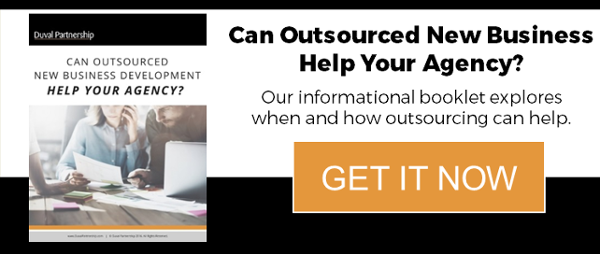When is the optimal time to invest in agency new business? Would you be surprised to learn it’s when your agency is already doing well? That’s when an agency is best-positioned to gain the most from outsourced new business services. Nevertheless, most agencies don’t contact us until they know they have a real problem on their hands.
New business is not a miracle cure. If your agency has operational issues and is not financially healthy, new business is the equivalent of putting a band-aid on an infection. It may be part of your solution, but it won’t fix deeper agency problems. So how can you tell when your agency is in danger of slipping into a financial crisis before it happens?

I spoke with agency consultant Karl Sakas about the benchmark KPIs that he uses to gauge agency health. Karl has advised hundreds of agency owners worldwide on conquering agency growing pains; Jay Baer calls him the “Dr. Phil of agency owners and managers.” Karl shared some of the numbers he considers to be key indicators of whether an agency is doing well or not.
Editor’s note: Interview has been edited for length and clarity.
What are some examples of indicators, key foundational characteristics, that would be in place when an agency is operating at a healthy baseline?
Karl: There are a few KPIs I consider. One is net profit margins; they should ideally be 20-30% before taxes. Importantly, that's 20-30% after owner compensation. Market rate is a six-figure salary for each owner; the exact amount will vary by agency size and location.
Another KPI is per capita revenue. You want at least $150,000 in revenue per full-time equivalent (FTE), and a billable ratio of at least 60%. That FTE count includes all employees, as well as recurring freelancers and contractors. For instance, two half-time employees would count as one FTE. A freelancer regularly working ten hours a week is effectively a 25% FTE. If revenue per FTE is below $100K, the agency is at risk of going out of business; it's definitely a viability problem. In contrast, above $200K is a positive.
Don’t spend more than 50-60% of your services revenues on labor, including owner compensation. If your net profit margins are less than 20-30%, I bet you’re over-spending on labor.
If we look at client turnover, ideally you’re retaining 80-90% of your business each year. If you’re project-based, that would likely be lower. But many agencies lose way more than 10-20% annually.
When I mentioned the 10-20% benchmark target for client turnover, one agency COO started laughing and said theirs is around 100% annually. As I dug in to find the root cause, it came down to poor sales qualification. The CEO pressured the sales team to say yes to clients who were a poor fit, and the clients rarely renewed.
That goes back to some agencies being too focused on new business rather than retention and upsells. You need both, but if you skew to filling the bucket without fixing a leaky bucket, you're going to be in trouble.
In your experience, how common is it for agencies to achieve any of those baselines, and how many agencies, when you start discussing these areas, just look at you blankly and have no idea?
Karl: Some agencies are doing great. At others, the owners aren’t even sure what their numbers are. If your revenue per FTE is $150K to $200K or higher, it's usually a sign that you're doing things right; you're likely charging enough for the work you're doing and you haven’t over-hired. Everyone has room for growth but few agencies do everything right. Someone needs to own monitoring and improving your KPIs, whether a COO or someone else.
Mark: Let’s say there's an owner of a small-to-medium size agency, and they’ve heard everything you have to say, and they’re thinking, “There's just no way in hell that I have the time to do this. I have a part-time bookkeeper, I'm chasing business, I’m doing everything but washing the floors here.” This question is for them:
What are the most important KPIs or metrics an agency owner should have? If you can only pick two or three, what would be the must-haves?
Karl: One would be per-capita services revenue, seeking $150K or more. If it's less, you want to get that up. If it’s below $100K, you should be in panic mode, because that's really bad.
Another is billable ratio; what percentage of your team's time is getting billed to clients — whether that's hourly, milestone, or value-based. Regardless of your pricing structure, your team's time is your agency's inventory. As I noted earlier, seek 60% or higher across your entire team.
Finally, I’d look at the strength of your sales pipeline. If your pipeline is weak, you’ll face trouble in the not-so-distant future.
Do you have any cautionary tales about agencies going after new business when they really need to be addressing other internal issues first?
Karl: Yes! A couple of years ago, I worked with a 40-person agency in Canada where the owner was amazing at sales. His 90-95% close rate was so high that I recommended he raise prices because he clearly wasn’t charging enough. But the problem was his handoff to the delivery teams. He would do what I called “deskside briefings.” After he closed a deal, he'd walk around the office, grab someone, tell them they're in charge of this new client, summarize the details verbally, and then walk away... having forgotten everything he just told them, much less anything he’d promised the client.
There were other things too. I learned from his management team that he never said no to a prospect. He’d offer a friends and family discount to almost everyone; at one point, he gave a nonprofit discount to a client that wasn't actually a nonprofit.
This out-of-control behavior had led to all kinds of problems for him and his team. In one case, he had worked for a year to close a million-dollar pharmaceutical marketing contract. He won the deal, walked out of the office and said (according to his management team), “We got the deal... now we're screwed.” He couldn't stop selling even when he recognized things were broken.
If you're closing lots of new business yet you're likely to drop the ball on delivery, that's a problem. I’ve found that sometimes agencies want to rebrand to fix their bad reputation on the fulfillment side. My advice is, if you've got operational problems, fix those before you rebrand. Otherwise, it's a “lipstick on a pig” situation.
Mark: It's interesting because our experience is we don’t see agencies closing a lot of business when they have a lot of operational problems. I can think of one particular agency we worked with where, because of their internal operations, we weren’t able to close business. It certainly affected our relationship with them. They weren’t able to give pricing for a project without a ridiculous amount of phone calls to get additional information first. There was one opportunity where they needed to have seven phone calls with the prospect. Seven. Just for pricing. I'm surprised that the prospect even allowed them to continue. Needless to say, they didn't get the business.
Karl: The agency probably had the wrong pricing model. If they needed that much information to provide a quote and then still didn't get the deal, they should've decoupled things and used a paid discovery process to reduce everyone’s risk, and then decide what to do from there. It sounds like they were trying to scope 100% upfront?
Mark: That's pretty accurate but it's also because of their lack of process internally. They would have someone designated as the lead but then they would still need to bring someone else in, and it wasn’t a simple approach to the opportunity. Then none of the people coordinated internally, so it ended up being a bunch of questions from multiple people who would be touching the business.
Karl: And I bet the client was thinking, I already told so-and-so about this. If a client has told one person at the agency, then from the client's perspective, they have told everyone at the agency.
Mark: Exactly. And it was a perfect example of what their experience would be like working with this agency.
Parting Thoughts
While we focus on agency new business at The Duval Partnership, it doesn’t exist in a vacuum. When an agency is operating in panic mode and resources are stretched, it affects the quality of work, employee morale, and client relationships, all of which bear on agency new business. Additionally, if the leadership is unable to get agency operations in good order, it’s unlikely they will be able to implement and consistently apply new business processes. These are all part of creating a solid foundation for the agency and being able to manage it effectively.
If your agency is falling short on operations and management, you aren’t alone! According to Hubspot’s Agency Pricing and Financials Report (2016), 15% of the respondents didn’t know their agency’s average profit margin, and another 14% estimated it so high that Drew McLellan (of the Agency Management Institute) speculated they either didn’t understand what profit margin meant, or that their books were a mess.
Do you track your agency’s KPIs? How would you rate your agency’s health?
This is the first of two blogs from our interview with Karl Sakas. The second one will address aspects of client management, so stay tuned!
Read more:
- Three Questions Agency Owners Should Ask — But Don't
- Common Questions From Agency Owners About New Business
- Agency Closings and How to Avoid Them
- When is the Right Time to Outsource Agency New Business?
- What are Fair Expectations for Outsourced New Business Outcomes?



